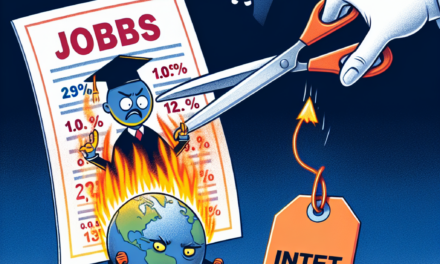“Boeing Stock Set to Soar: Specialist Predicts Growth Post-Breakup.”
Introduction
A recent analysis by a financial specialist suggests that Boeing’s stock may experience significant growth following a potential breakup of the company. This perspective is rooted in the belief that separating its commercial and defense divisions could enhance operational efficiency, streamline management, and unlock shareholder value. By focusing on distinct markets, Boeing could better address the unique challenges and opportunities within each sector, ultimately positioning itself for a more robust financial performance in the future.
Boeing’s Strategic Breakup: Implications for Stock Performance
In recent discussions surrounding Boeing’s corporate strategy, a specialist has suggested that a potential breakup of the aerospace giant could lead to a significant improvement in its stock performance. This perspective arises from the belief that a strategic division of Boeing’s operations could unlock value that has been obscured by its current structure. By separating its commercial airplane division from its defense and space segments, the company may enhance operational efficiency and focus, ultimately appealing to a broader range of investors.
The rationale behind this viewpoint is rooted in the distinct nature of Boeing’s business units. The commercial airplane sector, which has faced considerable challenges in recent years due to the pandemic and supply chain disruptions, operates under different market dynamics compared to the defense and space divisions. By spinning off these segments, Boeing could allow each entity to pursue tailored strategies that align more closely with their respective market conditions. This separation could lead to improved financial performance, as each division would be better positioned to respond to industry-specific challenges and opportunities.
Moreover, a breakup could facilitate a more transparent valuation of each business unit. Investors often struggle to assess the true worth of conglomerates, as the interdependencies between divisions can obscure individual performance metrics. By delineating the commercial and defense sectors, Boeing would provide clearer insights into revenue streams, profit margins, and growth potential. This transparency could attract investors who are specifically interested in either commercial aviation or defense contracting, thereby broadening the company’s shareholder base and potentially driving up stock prices.
In addition to enhancing clarity and focus, a strategic breakup could also foster innovation within each division. With the pressures of corporate bureaucracy alleviated, both the commercial and defense sectors could prioritize research and development initiatives that are critical for long-term competitiveness. For instance, the commercial division could concentrate on advancing sustainable aviation technologies, while the defense sector could invest in cutting-edge military systems. This renewed emphasis on innovation could lead to the development of new products and services, further bolstering revenue growth and enhancing stock performance.
Furthermore, the potential for increased shareholder value through a breakup is underscored by historical precedents in the aerospace and defense industries. Companies that have undergone similar transformations often experienced a positive market reaction, as investors recognized the benefits of focused operations. For example, when Northrop Grumman separated its shipbuilding division, the resulting entities were able to achieve higher valuations due to their specialized focus. Such outcomes suggest that Boeing could similarly benefit from a strategic realignment.
However, it is essential to acknowledge the challenges that a breakup could entail. The process of separating operations, aligning corporate cultures, and managing the transition could be complex and resource-intensive. Additionally, there may be regulatory hurdles to navigate, as antitrust concerns could arise from the restructuring. Nevertheless, if executed thoughtfully, the potential rewards could outweigh these risks.
In conclusion, the suggestion that Boeing’s stock could thrive following a strategic breakup is grounded in the belief that such a move would enhance operational efficiency, improve transparency, and foster innovation. By allowing each division to operate independently, Boeing could unlock significant value for its shareholders. As the company contemplates its future direction, the implications of a potential breakup warrant careful consideration, as they could reshape not only its operational landscape but also its stock performance in the years to come.
Analyst Insights: Why Boeing Stock Could Soar Post-Breakup
In recent discussions surrounding Boeing’s corporate structure, analysts have begun to speculate on the potential benefits of a breakup for the aerospace giant. This speculation is rooted in the belief that a separation of its commercial and defense operations could unlock significant value for shareholders. As the company grapples with various challenges, including production delays and regulatory scrutiny, the idea of a strategic split has gained traction among industry experts. A specialist in the field has suggested that such a move could lead to a substantial increase in Boeing’s stock price, presenting a compelling case for investors to consider.
One of the primary arguments in favor of a breakup is the distinct nature of Boeing’s commercial and defense businesses. Each segment operates under different market dynamics, regulatory environments, and competitive pressures. By separating these divisions, Boeing could allow each entity to focus on its core competencies, thereby enhancing operational efficiency and strategic agility. For instance, the commercial aviation sector is heavily influenced by global travel trends and economic cycles, while the defense sector is more insulated from such fluctuations, often benefiting from long-term government contracts. This divergence suggests that a breakup could enable each division to pursue tailored strategies that align more closely with their respective market conditions.
Moreover, a breakup could potentially attract a broader range of investors. Currently, Boeing’s stock is viewed as a conglomerate, which may deter some investors who prefer to invest in companies with a more focused business model. By splitting into two distinct entities, Boeing could appeal to a wider array of institutional and retail investors, each seeking exposure to either commercial aviation or defense. This increased investor interest could drive up demand for the stock, ultimately leading to a higher valuation for both companies.
In addition to attracting new investors, a breakup could also facilitate more transparent financial reporting. Currently, the complexities of Boeing’s financials can obscure the performance of each division, making it challenging for investors to assess the company’s overall health. By separating the businesses, each entity would be required to report its financial results independently, providing clearer insights into profitability and growth prospects. This transparency could enhance investor confidence and lead to more informed decision-making, further supporting a potential rise in stock prices.
Furthermore, the breakup could enable Boeing to streamline its operations and reduce costs. With a more focused approach, each division could eliminate redundancies and optimize resource allocation. This operational efficiency could translate into improved margins and profitability, which are critical factors that investors consider when evaluating a company’s stock. As both entities work to enhance their competitive positions, the potential for increased earnings could make them more attractive to investors.
In conclusion, the prospect of a breakup presents a unique opportunity for Boeing to revitalize its stock performance. By allowing its commercial and defense operations to operate independently, the company could enhance operational efficiency, attract a broader investor base, and provide clearer financial insights. As analysts continue to evaluate the implications of such a strategic move, it becomes increasingly evident that a breakup could serve as a catalyst for significant growth in Boeing’s stock value. Investors would do well to monitor these developments closely, as the potential for a thriving future hinges on the decisions made in the coming months.
The Future of Boeing: A Specialist’s Perspective on Stock Growth
In recent discussions surrounding the future of Boeing, a prominent specialist has suggested that the company’s stock could experience significant growth following a potential breakup. This perspective arises from a comprehensive analysis of Boeing’s current operational challenges and market dynamics, which have prompted investors to reconsider the company’s long-term viability. As Boeing navigates a complex landscape marked by regulatory scrutiny, supply chain disruptions, and competitive pressures, the notion of a breakup has gained traction among analysts and investors alike.
The rationale behind this viewpoint is multifaceted. First and foremost, a breakup could allow Boeing to streamline its operations, focusing on its core competencies while shedding non-essential divisions that may be dragging down overall performance. By separating its commercial aircraft division from its defense and space segments, Boeing could enhance operational efficiency and foster a more agile corporate structure. This strategic realignment could lead to improved financial performance, as each entity would be better positioned to respond to market demands and capitalize on growth opportunities.
Moreover, the potential breakup could attract a new wave of investors who are currently hesitant to engage with Boeing due to its perceived complexities and risks. By simplifying its corporate structure, Boeing could present a more compelling investment case, appealing to those who prioritize clarity and transparency in their investment decisions. This shift in investor sentiment could drive up demand for Boeing’s stock, ultimately leading to a more favorable valuation.
In addition to operational efficiencies, a breakup could also facilitate targeted investments in innovation and technology. Each newly formed entity would have the autonomy to pursue its strategic initiatives, allowing for a more focused approach to research and development. This could be particularly beneficial in the aerospace sector, where technological advancements are crucial for maintaining competitive advantage. By fostering a culture of innovation within each division, Boeing could position itself to capitalize on emerging trends, such as sustainable aviation and advanced manufacturing techniques.
Furthermore, the specialist’s perspective highlights the potential for enhanced shareholder value through a breakup. As the market increasingly rewards companies that demonstrate clear growth trajectories and robust financial health, a streamlined Boeing could be well-positioned to deliver on these expectations. Shareholders may benefit from improved earnings per share and increased dividends, as the company reallocates resources more effectively across its divisions. This potential for enhanced returns could further bolster investor confidence and drive stock prices higher.
However, it is essential to acknowledge the inherent risks associated with such a significant corporate restructuring. The process of breaking up a large conglomerate like Boeing is fraught with challenges, including potential disruptions to operations, the need for regulatory approvals, and the complexities of managing multiple entities. Nevertheless, the specialist remains optimistic that the long-term benefits of a breakup could outweigh these risks, particularly in a rapidly evolving aerospace market.
In conclusion, the specialist’s insights into Boeing’s potential for stock growth following a breakup present a compelling narrative for investors. By focusing on operational efficiencies, fostering innovation, and enhancing shareholder value, a restructured Boeing could emerge as a more resilient and competitive player in the aerospace industry. As the market continues to evolve, stakeholders will undoubtedly be watching closely to see how Boeing navigates this pivotal juncture in its corporate journey.
Breaking Down Boeing: How a Split Could Benefit Investors
In recent discussions surrounding Boeing’s corporate structure, a specialist has suggested that a potential breakup of the aerospace giant could yield significant benefits for investors. This perspective arises from a growing recognition of the complexities and challenges that Boeing faces as a single entity, particularly in light of its diverse operations spanning commercial aviation, defense, and space exploration. By examining the implications of a split, it becomes evident that such a move could enhance operational efficiency, unlock shareholder value, and ultimately lead to a more focused strategic direction for each segment.
To begin with, the intricacies of Boeing’s multifaceted business model have often led to operational inefficiencies. The company’s commercial and defense divisions, while both critical to its overall success, operate under vastly different market dynamics and regulatory environments. A breakup could allow each division to concentrate on its core competencies, thereby streamlining operations and improving decision-making processes. For instance, the commercial aviation sector could focus on innovation and customer service, while the defense division could prioritize government contracts and technological advancements. This specialization could foster a more agile corporate structure, enabling each entity to respond more effectively to market demands and competitive pressures.
Moreover, a split could unlock significant shareholder value. Investors have long expressed concerns about Boeing’s stock performance, particularly in the wake of the 737 MAX crisis and the ongoing challenges posed by the COVID-19 pandemic. By separating its commercial and defense operations, Boeing could potentially create two distinct investment opportunities, each with its own growth trajectory and risk profile. This separation could attract a broader range of investors, including those who may prefer the stability of defense contracts over the cyclical nature of commercial aviation. Consequently, the market could assign a more favorable valuation to each entity, reflecting their individual strengths and growth prospects.
In addition to operational efficiency and enhanced shareholder value, a breakup could also facilitate a more focused strategic direction for each segment. Currently, Boeing’s leadership must navigate the complexities of managing a diverse portfolio, which can dilute strategic initiatives and hinder long-term planning. By splitting into separate entities, each division could develop tailored strategies that align with its specific market conditions and competitive landscape. For example, the commercial aviation segment could prioritize sustainability initiatives and technological advancements in aircraft design, while the defense division could focus on expanding its capabilities in emerging technologies such as artificial intelligence and cybersecurity. This focused approach could lead to more innovative solutions and improved market positioning for both entities.
Furthermore, the potential breakup of Boeing could also have positive implications for its workforce. A more streamlined organizational structure could lead to clearer roles and responsibilities, fostering a culture of accountability and performance. Employees would likely benefit from a more defined corporate mission, which could enhance job satisfaction and retention rates. Additionally, as each entity pursues its strategic objectives, there may be increased opportunities for professional development and career advancement within specialized fields.
In conclusion, the prospect of a breakup presents a compelling case for investors considering Boeing’s future. By enhancing operational efficiency, unlocking shareholder value, and allowing for a more focused strategic direction, a split could position both the commercial and defense divisions for greater success in their respective markets. As the aerospace industry continues to evolve, the potential benefits of such a transformation warrant careful consideration from stakeholders looking to navigate the complexities of Boeing’s corporate landscape.
Market Reactions: Boeing Stock Trends After the Breakup Announcement
In the wake of the recent announcement regarding Boeing’s potential breakup, market reactions have been swift and multifaceted, reflecting a complex interplay of investor sentiment and strategic forecasting. Analysts have begun to assess the implications of this significant corporate restructuring, with many suggesting that the separation of Boeing’s commercial and defense divisions could ultimately enhance shareholder value. This perspective is rooted in the belief that a more focused operational structure may allow each entity to pursue tailored strategies that align more closely with their respective markets.
As the news broke, Boeing’s stock experienced immediate fluctuations, indicative of the uncertainty that often accompanies such transformative decisions. Initially, there was a dip in share prices as investors grappled with the potential risks associated with a breakup, including the costs of separation and the challenges of establishing two independent entities. However, as analysts began to articulate the long-term benefits of this strategic move, a more optimistic outlook emerged. This shift in sentiment was bolstered by the notion that a breakup could lead to improved operational efficiencies and a clearer strategic vision for both divisions.
Moreover, the defense sector, which has historically been a strong performer for Boeing, stands to gain from increased focus and investment. Analysts have pointed out that the defense division could capitalize on rising global military expenditures and heightened geopolitical tensions, which may drive demand for advanced aerospace technologies. Consequently, this could position Boeing’s defense segment for robust growth, further enhancing its attractiveness to investors. In contrast, the commercial division, while facing challenges such as fluctuating demand and supply chain disruptions, may benefit from a renewed focus on innovation and customer service, allowing it to adapt more swiftly to market changes.
Transitioning from the immediate market reactions to the broader implications, it is essential to consider how this potential breakup aligns with industry trends. The aerospace sector is undergoing significant transformation, driven by technological advancements and shifting consumer preferences. By separating its divisions, Boeing could better align its resources and strategies with these evolving trends, thereby enhancing its competitive edge. This strategic realignment may also attract new investors who are specifically interested in either the commercial or defense sectors, thereby broadening the company’s shareholder base.
Furthermore, the potential breakup has sparked discussions about the overall health of Boeing as a company. While the past few years have been fraught with challenges, including production delays and safety concerns, the prospect of a more streamlined organization could signal a turning point. Investors are increasingly looking for signs of resilience and adaptability, and a breakup may be perceived as a proactive step towards revitalizing the brand and restoring confidence in its long-term prospects.
In conclusion, while the initial market reactions to Boeing’s breakup announcement were marked by uncertainty, the prevailing sentiment appears to be shifting towards optimism. Analysts suggest that the separation of Boeing’s commercial and defense divisions could unlock significant value for shareholders, allowing each entity to thrive in its respective market. As the aerospace industry continues to evolve, this strategic move may position Boeing to better navigate future challenges and capitalize on emerging opportunities. Ultimately, the success of this endeavor will depend on the execution of the breakup and the ability of each division to adapt to the dynamic landscape of the aerospace sector.
Investment Strategies: Capitalizing on Boeing’s Potential Post-Division
In recent discussions surrounding Boeing’s corporate structure, a specialist has suggested that the company’s stock could experience significant growth following a potential breakup. This perspective invites investors to consider various strategies that could capitalize on Boeing’s potential in a post-division landscape. As the aerospace giant navigates challenges, including regulatory scrutiny and operational inefficiencies, the prospect of a breakup may serve as a catalyst for unlocking value within its diverse business segments.
To begin with, it is essential to understand the rationale behind the breakup suggestion. Boeing operates in multiple sectors, including commercial aviation, defense, and space exploration. Each of these divisions has distinct operational dynamics and market conditions. By separating these segments, the company could enhance focus and agility, allowing each division to pursue tailored strategies that align with its specific market demands. This increased specialization could lead to improved performance metrics, which, in turn, may attract investors seeking growth opportunities.
Moreover, a breakup could facilitate a more transparent valuation of each business unit. Currently, investors may find it challenging to assess the true worth of Boeing’s various operations due to the conglomerate’s complex financial structure. By spinning off divisions, investors would have clearer insights into the profitability and growth potential of each segment. This transparency could lead to more informed investment decisions, ultimately driving up stock prices as market participants recognize the inherent value of the individual entities.
In addition to transparency, a breakup could also enhance operational efficiency. Each newly formed entity would have the autonomy to streamline processes, reduce redundancies, and innovate more rapidly. For instance, the commercial aviation division could focus on developing next-generation aircraft without the constraints imposed by the defense sector’s regulatory environment. Similarly, the defense division could prioritize military contracts and technological advancements without the distractions of commercial market fluctuations. This operational focus could result in improved margins and higher returns on investment, making the stock more attractive to both institutional and retail investors.
Furthermore, the potential for strategic partnerships and collaborations could increase in a post-breakup scenario. Independent entities may find it easier to forge alliances with other companies, whether in technology, manufacturing, or supply chain management. These partnerships could lead to enhanced innovation and market competitiveness, further driving stock performance. Investors should keep an eye on how these collaborations unfold, as they could significantly impact the growth trajectories of the newly formed companies.
As investors contemplate their strategies in light of these developments, it is crucial to remain vigilant about market trends and economic indicators that could influence Boeing’s stock performance. Factors such as global travel demand, defense spending, and technological advancements in aerospace will play pivotal roles in shaping the future landscape. By staying informed and adaptable, investors can position themselves to take advantage of the opportunities that may arise from Boeing’s potential breakup.
In conclusion, the prospect of a breakup presents a unique opportunity for investors to reassess their strategies regarding Boeing stock. By focusing on the potential benefits of increased specialization, transparency, operational efficiency, and strategic partnerships, investors can better navigate the complexities of the aerospace market. As the situation evolves, those who remain proactive and informed will be well-positioned to capitalize on Boeing’s potential in a post-division environment.
Comparing Boeing’s Breakup to Other Successful Corporate Splits
In recent discussions surrounding Boeing’s potential breakup, analysts have drawn parallels to other successful corporate splits that have led to enhanced shareholder value and operational efficiency. The notion of breaking up a conglomerate into more focused entities is not new; history has shown that such strategic decisions can yield significant benefits. For instance, when General Electric (GE) announced its plan to divest various segments of its business, the market responded positively, reflecting investor confidence in the streamlined operations that would follow. This historical precedent suggests that Boeing could similarly thrive if it were to separate its commercial and defense divisions, allowing each to concentrate on its core competencies.
Moreover, the case of Hewlett-Packard (HP) serves as another compelling example. In 2015, HP split into two distinct companies: HP Inc., which focused on personal computers and printers, and Hewlett Packard Enterprise, which concentrated on enterprise products and services. This division allowed both entities to pursue tailored strategies that better aligned with their respective markets. Following the split, both companies experienced a resurgence in stock performance, demonstrating that a focused approach can lead to improved operational agility and market responsiveness. Such outcomes could be mirrored in Boeing’s case, where a breakup might enable each division to innovate and compete more effectively in their respective sectors.
Transitioning to the telecommunications industry, the breakup of AT&T in the 1980s provides another illustrative example. The divestiture of its regional Bell operating companies resulted in a more competitive landscape, ultimately benefiting consumers and investors alike. The newly formed entities were able to specialize in their services, leading to advancements in technology and customer service. This historical context reinforces the idea that Boeing’s potential separation could foster a similar environment of innovation and competition, ultimately enhancing shareholder value.
Furthermore, the automotive industry has also witnessed successful breakups that have led to revitalized companies. The split of Fiat Chrysler Automobiles into distinct brands allowed for more focused marketing and product development strategies. Each brand could cater to its target demographic without the constraints of a larger corporate structure. This strategic realignment not only improved operational efficiency but also resulted in a more robust market presence for each brand. In the same vein, Boeing’s divisions could benefit from a similar approach, allowing them to tailor their strategies to the unique demands of the aerospace and defense markets.
As Boeing navigates its current challenges, the potential for a breakup could serve as a catalyst for renewed growth and profitability. By examining the successes of other corporate splits, it becomes evident that a focused approach can lead to enhanced performance and shareholder satisfaction. The lessons learned from these historical examples underscore the importance of specialization in an increasingly competitive landscape. If Boeing were to pursue a breakup, it could unlock new opportunities for innovation and operational excellence, positioning itself for long-term success.
In conclusion, the prospect of Boeing’s breakup is not merely a theoretical exercise; it is grounded in a rich history of corporate restructuring that has yielded positive outcomes for many companies. By learning from the experiences of others, Boeing may find that a strategic separation could pave the way for a more prosperous future, ultimately benefiting its shareholders and stakeholders alike. As the market continues to evolve, the potential for Boeing to thrive post-breakup remains an intriguing possibility worth considering.
Q&A
1. **Question:** What is the main reason a specialist suggests Boeing stock could thrive after a breakup?
**Answer:** The specialist believes that breaking up Boeing into smaller, more focused companies could enhance operational efficiency and unlock shareholder value.
2. **Question:** What specific segments of Boeing might be considered for a breakup?
**Answer:** The commercial airplane division, defense, space, and services segments are potential candidates for separation.
3. **Question:** How could a breakup impact Boeing’s financial performance?
**Answer:** A breakup could lead to improved financial performance by allowing each entity to focus on its core competencies and potentially attract more targeted investments.
4. **Question:** What are the potential risks associated with breaking up Boeing?
**Answer:** Risks include potential loss of synergies, increased operational costs, and challenges in managing separate entities.
5. **Question:** How have investors reacted to the idea of a Boeing breakup?
**Answer:** Investor reactions have been mixed, with some expressing optimism about potential value creation, while others are concerned about the execution and transition challenges.
6. **Question:** What historical examples support the idea of successful breakups in the aerospace industry?
**Answer:** Historical examples include the breakup of Lockheed Martin and Northrop Grumman, which led to increased focus and profitability for the resulting companies.
7. **Question:** What is the timeline for any potential breakup of Boeing?
**Answer:** There is no definitive timeline, as discussions are still in the early stages and would require significant strategic planning and regulatory approvals.
Conclusion
A specialist suggests that Boeing stock could thrive following a potential breakup of the company, as this could lead to a more focused and efficient operation, unlocking value for shareholders. The separation of its commercial and defense segments may enhance operational performance, attract investment, and improve market competitiveness, ultimately positioning Boeing for stronger financial growth in the long term.





